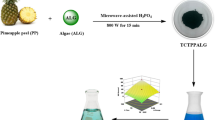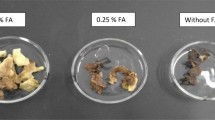Abstract
The growing environmental concern in all segments of society has aroused the interest of the scientific community in the search for alternatives to reduce the use of pesticides, getting highlighted the use of antagonists microorganisms, as species of Trichoderma. Despite many years of research, several challenges such as lack of formulations, storage and transport conditions, which reduce the viability of microorganisms, hamper the application of this technology in large scales. A polymeric formulation that retains the characteristics and properties of the antagonist is of fundamental importance for an efficient and effective control of the disease to be fought. Encapsulation into beads may be an alternative to provide protection and maintain the properties of these microorganisms. In this paper, applying the factorial design tool, was studied a formulation having as independent variables the proportion of sodium alginate, sodium polyphosphate and glycerol aiming to increase the water activity (aW) of the beads. The beads were prepared using the technique of drip by simple ionic gelation of biopolymers in solutions of CaCl2 (2M). Characterization of beads was held by FTIR spectrophotometer and thermogravimetric analysis. Results indicate that the greater proportion of polyphosphate formulation was more significant for a larger aW into the beads. Preliminary results show that beads formulation with alginate, polyphosphate and glycerol was able to maintain the viability of spores of Trichoderma sp. for 120 days when stored at room temperature.
Graphical Abstract
The water activity (aW) of the samples was evaluated and had different responses that depended on the composition of granules. The surface chart represents the responses of aW for Ca-AGP beads. Figure shows the Pareto diagram, where it can be seen that only the concentration of polyphosphate was significantly variable in aW response. The distribution of the residuals (values predicted by the model vs. observed values) showed that the deviations were normally distributed and that there was a satisfactory correlation between the theoretical and experimental values.







Similar content being viewed by others
References
Bae YR, Knudsen GR (2005) Soil microbial biomass influence on growth and biocontrol efficacy of Trichoderma harzianum. Biol Control 32:236–242
W Bettiol, MAB Morandi (2009) Biocontrole de doenças de plantas: uso e perspectivas. Embrapa Meio Ambiente, 341 p
IS Melo, FG Costa (2005) Desenvolvimento de uma Formulação Granulada a Base de Trichoderma harzianum para Controle de Fitopatógenos. Embrapa Comunicado Técnico, pp 1–4
Christensen BE, Characklis WG (1990) Physical and chemical properties of biofilms. In: Characklis WG, Marshall KC (eds) biofilms. Wiley, New York, p 93
Jackson LS et al (1991) Microencapsulation and food industry. LWT Food Sci Technol 24(4):289–297
Kruif CG, Weinbrecka F, Vries R (2004) Complex coacervation of proteins and anionic polysaccharides. Curr Opin Colloid Interface Sci 9:340–349
Adzmi F, Meon S, Musa MH, Yusu NA (2012) Preparation, characterization and viability of encapsulated Trichoderma harzianum UPM40 in alginate-montmorillonite clay. J Microencapsul 29(3):205–210
Naseby DC, Pascual JA, Lynch JM (2000) Effect of biocontrol strains of Trichoderma on plant growth, Pythium ultimum populations, soil microbiol communities and soil enzyme activities. J Appl Microbiol 88(1):161–169
Pawar SN, Edgar KJ (2012) Alginate derivatization: a review of chemistry, properties and application. Biomaterials 33:3279–3305
Workman VL, Tezera LB, Elkington PT, Jayasinghe SN (2014) Controlled generation of microspheres incorporating extracellular matrix fibrils for three-dimensional cell culture. Adv Funct Mater 24(2014):2648–2657
Rodrigues D, Rocha-Santos T, Sousa S, Gomes AM, Pintado MM, Malcata FX, Lobo JMS, Silva JP, Costa P, Amaral MH, Freitas AC (2011) On the viability of five probiotic strains when immobilized on various polymers. Int J Dairy Technol 64:137–144
Jiménez-Pranteda ML, Poncelet D, Náder-Macías ME, Arcos A, Aguilera M, Monteoliva-Sánchez M, Ramos-Cormenzana A (2012) Stability of lactobacilli encapsulated in various microbial polymers. J Biosci Bioeng 113(2):179–184
Yancey PH, Clark ME, Hand SC, Bowlus RD, Somero G (1982) Living with water stress: evolution of osmolyte systems. Science 21(4566):1214–1222
Viana YA, Garrote-Filho MS, Penha-Silva N (2005) Estabilização de proteínas por osmólitos. Biosci J 21(2):83–88
Diamant S, Eliahu N, Rosenthal D, Goloubinoff P (2001) Chemical chaperones regulate molecular chaperones in vitro and in cells under combined salt and heat stresses. J Biol Chem 276(43):39586–39591
Arruda PV, Rodrigues RCLB, Felipe MGA (2007) Glicerol: um subproduto com grande capacidade industrial e metabólica. Rev Anal 26:56–62
Nevoigt E, Stahl U (1997) Osmoregulation and glycerol metabolism in the yeast Saccharomyces cerevisiae. FEMS Microb Rev 21:231–241
Shari’a AEN, Nascimento AE, Lima MAB, Campos-Takaki GM, Souza W (2002) Polyphosphate in Zygomycetes: a cytochemical study. Braz J Microbiol 33:119–126
Kulaev IS, Vagabov VM (1983) Polyphosphate metabolism in microorganisms. Adv Microbiol Physiol 24:83–169
Harold FM (1966) Inorganic polyphosphate in biology: structure, metabolism and function. Bacteriol Rev 13:772–794
FM Harold (2015) Water activity. Replacing myths with science. http://www.wateractivity.org/. Accessed 16 Feb 2015
Björklund S, Wadsö L (2011) A calorimetric method to determine water activity. Rev Sci Instrum 82:114903
Jackisch-Matsuura A, Menezes M (1999) Efeito de Trichoderma spp. no controle de Pythium aphanidermatum em fumo (Nicotiana tabacum). Summa Phytopathologuca 25(2):161–164
Lima JR, Locatelli GO, Finkler L, Luna-Finkler CL (2014) Incorporação de Lactobacillus casei microencapsulado em queijo tipo coalho. Revista Ciência & Saúde 7(1):27–34
Carta D, Knowles JC, Smith ME, Newport RJ (2007) Synthesis and structural characterization of P2O5–CaO–Na2O sol–gel materials. J Non-Cryst Solids 353:1141–1149
Narra K, Dhanalekshmi U, Rangaraj G, Raja D, Kumar CS, Reddy PN, Mandal AB (2012) Effect of formulation variables on rifampicin loaded alginate beads. Iran J Pharm Res 11(3):715–721
Pongjanyakul T, Puttipipatkhachorn S (2007) Modulating drug release and matrix erosion of alginate matrix capsules by microenvironmental interaction with calcium ion. J Non-Cryst Solids 353:1141–1149
Parikh A, Madamwar D (2006) Partial characterization of extracellular polysaccharides from cyanobacteria. Bioresour Technol 97:1822–1827
Marinho-Soriano E, Bourret E (2005) Polysaccharides from the red seaweed Gracilaria dura (Gracilariales, Rhodophyta). Bioresour Technol 96:379–382
Wang Y, Li C, Liu P, Ahmed Z, Xiao P, Bai X (2010) Physical characterization of exopolysaccharide produced by Lactobacillus plantarum KF5 isolated from Tibet Kefir. Carbohydr Polym 82:895–903
Morrison LR (1994) Glycerol. Encyclopedia of chemical technology. Wiley, New York, pp 921–932
Acknowledgments
The financial support for this research by CNPq (Conselho Nacional de Desenvolvimento Científico e Tecnológico—Grant Number 486589/2013-7) and FACEPE (Fundação de Amparo a Ciência e Tecnologia do Estado de Pernambuco—Grant Number APQ-0227-1.06/11) is gratefully acknowledged. Tibério Vasconcelos was supported by a studentship from CAPES (Coordenação de Aperfeiçoamento de Pessoal de Ensino Superior), and Magali Amorim, Gabriel dos Santos and Priscilla Botelho were supported by a studentship from FACEPE. Luciano Avallone Bueno would like to thank the support of UFRPE (Universidade Federal Rural de Pernambuco), Rede Nordeste de Biotecnologia (RENORBIO) and Universidade de Sorocaba (UNISO).
Conflict of interest
The authors declare that they have no conflict of interest.
Author information
Authors and Affiliations
Corresponding author
Rights and permissions
About this article
Cite this article
dos Santos, G.F., Locatelli, G.O., Coêlho, D.A. et al. Factorial design, preparation and characterization of new beads formed from alginate, polyphosphate and glycerol gelling solution for microorganism microencapsulation. J Sol-Gel Sci Technol 75, 345–352 (2015). https://doi.org/10.1007/s10971-015-3705-5
Received:
Accepted:
Published:
Issue Date:
DOI: https://doi.org/10.1007/s10971-015-3705-5




